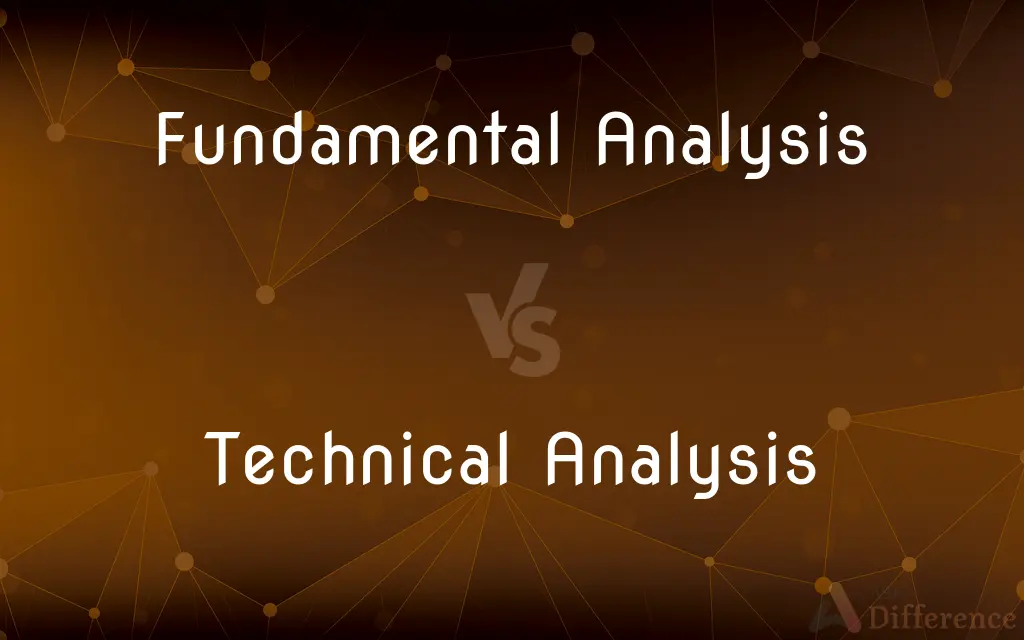Fundamental Analysis vs. Technical Analysis — What's the Difference?
By Tayyaba Rehman — Published on December 4, 2023
Fundamental Analysis evaluates a company's intrinsic value using financial & economic factors. Technical Analysis studies price patterns & market trends using charts.

Difference Between Fundamental Analysis and Technical Analysis
Table of Contents
ADVERTISEMENT
Key Differences
Fundamental Analysis is a method used to determine the intrinsic value of a security by examining related economic, financial, and other qualitative and quantitative factors. Technical Analysis, on the other hand, focuses on studying price movements and using historical price data to forecast future price movements.
In Fundamental Analysis, investors analyze company-specific factors such as earnings, financial statements, and overall financial health. In contrast, Technical Analysis is more concerned with patterns found in stock charts, such as head and shoulders or double tops, to predict future movements.
Fundamental Analysis is grounded in the belief that by analyzing and understanding a company's financial statements and health, one can forecast its future performance. Technical Analysis operates on the idea that market price movements follow predictable patterns and that past price performance can indicate future activity.
A key difference is the timeframe. Fundamental Analysis might be used for long-term investment decisions, assessing whether a company's stock is over or underpriced. Technical Analysis, conversely, is often used for short-term trading opportunities, relying on chart patterns and indicators.
Comparison Chart
Basis
Company's financials & economic factors
Price patterns & historical data
ADVERTISEMENT
Main Tools
Earnings, balance sheets, P/E ratios
Charts, technical indicators
Time Frame
Generally long-term
Short-term
Primary Belief
Intrinsic value can be determined through deep analysis
Prices move in trends & patterns
Data Source
Financial statements, industry data, macroeconomic data
Stock charts, trading volume
Compare with Definitions
Fundamental Analysis
Fundamental Analysis deciphers a company's value relative to its stock price.
By applying Fundamental Analysis, he deduced the stock was a bargain.
Technical Analysis
Technical Analysis involves studying price charts and patterns.
With Technical Analysis, she identified a bullish trend in the stock.
Fundamental Analysis
Fundamental Analysis assesses a security's intrinsic value by examining related economic indicators.
Through Fundamental Analysis, he realized the company was poised for growth.
Technical Analysis
Technical Analysis operates on the premise that market prices move in trends.
His Technical Analysis indicated a potential breakout from its current range.
Fundamental Analysis
Fundamental Analysis involves studying financial statements, company news, and external events.
Fundamental Analysis revealed the company's strong cash flow and debt position.
Technical Analysis
Technical Analysis predicts future price movements based on historical data.
Traders use Technical Analysis to spot potential buy or sell signals.
Fundamental Analysis
Fundamental Analysis uses both qualitative and quantitative data to make investment decisions.
Based on Fundamental Analysis, she believed the company had strong future prospects.
Technical Analysis
Technical Analysis is often used to determine entry and exit points for trading.
Based on Technical Analysis, she decided it was time to sell the stock.
Fundamental Analysis
Fundamental Analysis is the evaluation of a company's financial health.
Investors use Fundamental Analysis to determine if a stock is undervalued.
Technical Analysis
Technical Analysis relies on indicators like moving averages or RSI.
Using Technical Analysis, he noted the stock was in overbought territory.
Common Curiosities
Which analysis is more suited for long-term investments?
Fundamental Analysis is generally better suited for long-term investments.
What are the key tools used in Fundamental Analysis?
Earnings reports, balance sheets, and economic indicators are primary tools in Fundamental Analysis.
Is Fundamental Analysis subjective?
While it relies on concrete data, interpretations in Fundamental Analysis can be subjective.
Can Technical Analysis be used in any market?
Yes, Technical Analysis can be applied to any market with historical trading and price data.
What is the main goal of Fundamental Analysis?
Fundamental Analysis seeks to determine a company's intrinsic value.
How does Technical Analysis differ from Fundamental Analysis in approach?
While Technical Analysis studies price patterns, Fundamental Analysis evaluates financial and economic data.
Can Technical Analysis help in predicting short-term price movements?
Yes, Technical Analysis is often used to predict short-term price trends.
Which analysis believes in market efficiency?
Fundamental Analysis operates on the belief that markets may be inefficient and that a stock can be undervalued or overvalued.
Are stock charts essential for Technical Analysis?
Yes, stock charts are fundamental in Technical Analysis to study price patterns.
Which analysis primarily relies on qualitative data?
Fundamental Analysis often considers qualitative factors like management quality and industry position.
Which is more beginner-friendly, Fundamental Analysis or Technical Analysis?
Both have their complexities, but some beginners might find Technical Analysis more visually intuitive due to its emphasis on charts.
Can Fundamental Analysis change based on external events?
Yes, external events like political changes or natural disasters can influence Fundamental Analysis.
How reliable is Technical Analysis?
Technical Analysis is a tool, and its reliability can vary based on its application and market conditions.
Can both Fundamental Analysis and Technical Analysis be used together?
Yes, many investors use both methods in tandem to make more informed decisions.
What's a common misconception about Technical Analysis?
A misconception is that Technical Analysis guarantees future price movements; it provides probable scenarios based on past data.
Share Your Discovery

Previous Comparison
Varchar vs. Nvarchar
Next Comparison
CDMA vs. WCDMAAuthor Spotlight
Written by
Tayyaba RehmanTayyaba Rehman is a distinguished writer, currently serving as a primary contributor to askdifference.com. As a researcher in semantics and etymology, Tayyaba's passion for the complexity of languages and their distinctions has found a perfect home on the platform. Tayyaba delves into the intricacies of language, distinguishing between commonly confused words and phrases, thereby providing clarity for readers worldwide.












































